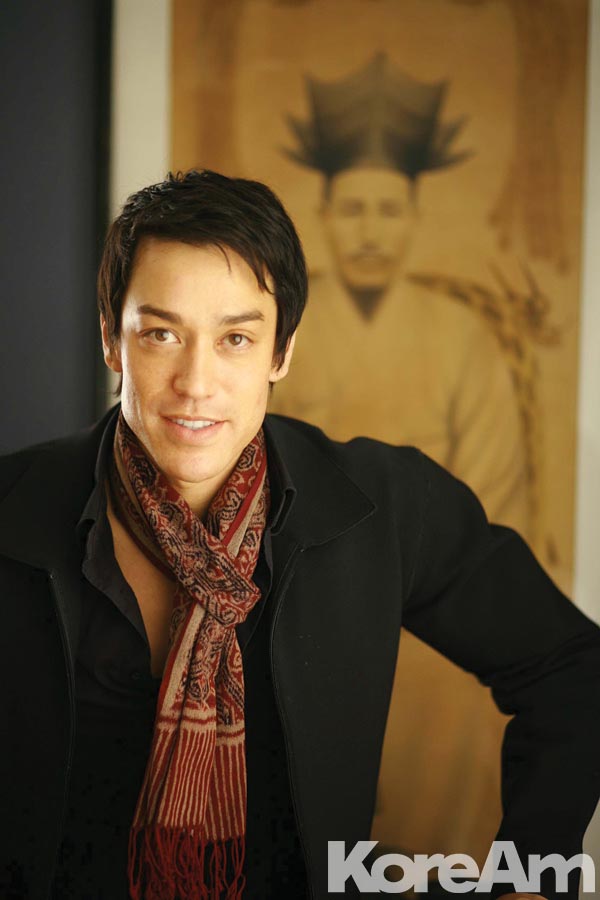In his new work, “We Chose to go to the Moon,” the acclaimed choreographer explores our relationship to the cosmos.
by ALEX HYUN
Above photo by MARY NOBLE OURS
As 2013 was drawing to a close for dancer and choreographer Dana Tai Soon Burgess, trips back to his parents’ home in Santa Fe, New Mexico, had become more frequent. His 89-year-old father was ill, and the Washington, D.C.-based artist wished to spend as much time with him as possible.
It was during one of these plane rides to the heart of the Southwest that Burgess happened to be seated besides
Barbara Zelon, the communications manager for the Orion Spacecraft at NASA.
“I’m sitting on the plane and had this stuffed Elroy from The Jetsons [the animated 1960s sitcom set in a futuristic wonderland] next to my seat and was taking pictures of it for Facebook and what not,” Burgess recalls to KoreAm, speaking by phone from his home in D.C. “The next thing I know, a woman shows up [to take her seat] and gives me NASA patches because she notices the Elroy doll.”
Zelon and Burgess began talking about their respective careers—hers in the space exploration field and his in modern dance and choreography. Zelon had also enrolled her daughter in dance classes and the pair found they had a lot in common. “We started talking about what NASA does, and I thought she was a great spokesperson for the organization,” he says.
Their conversation was still fresh in his mind when the artist later found himself sitting on his parents’ porch in
Santa Fe, gazing up at the stars, mulling over their beauty and contemplating the space pioneers from his father’s generation. The questions and concepts of the heavens and space occupied Burgess’ mind, and he found inspiration for his next project: a work about people’s relationship to space, the mystery of the cosmos and the fragility of life.
The choreographer contacted Zelon about his idea for the project—an artistic expression of humankind’s relationship to space, conveyed through individual stories—and a collaboration was born.
“She totally understood it because so much of what NASA is trying to do is disperse available information about the theories and concepts discovered about space,” Burgess says. “[NASA] is always interested in disseminating information through traditional ways and non-traditional methods such as art.”
“We Choose to go to the Moon,” the choreographer’s latest work, will make its world premiere Sept. 19 at the John F. Kennedy Center for the Performing Arts in D.C. Its title is a reference to President John F. Kennedy’s 1962 speech to the nation about the space race. The work, which will travel around to NASA sites following its debut, is dedicated to Burgess’ late father, Joseph James Burgess, Jr., a visual artist who passed away on Nov. 1, 2014, at age 90, as well as his generation of fellow Americans who witnessed the Apollo 11 moon landing in 1969.
 From left to right: Dancers Kelly Southall, Alvaro Palau and Sarah Halzack in “We Choose to go to the Moon.” Photo by Jeff Watts.
From left to right: Dancers Kelly Southall, Alvaro Palau and Sarah Halzack in “We Choose to go to the Moon.” Photo by Jeff Watts.
“It’s very much an ode to [my father] and that generation; it’s nostalgic of that time period when we went up to the moon,” says Burgess, who, as well as being a mix of Scottish, Irish, German and English, is half-Korean. His mother, Anna Kang Burgess, is the granddaughter of Chin Hyung Chai and Man Soo Kang, who were among the first group of Korean immigrants to come to America in the early 1900s to work as plantation workers in Hawaii.
Throughout his professional dance career, the 47-year-old Burgess has explored the theme of cultural identity and the multifaceted American cultural landscape via the company he established in 1992—Moving Forward: Contemporary Asian American Dance Company, which later became the Dana Tai Soon Burgess Dance Company. His objective has been to relay larger concepts on an individual level in order to create empathetic dialogue. His 2003 work, “Tracing,” explored Korean immigration through the personal perspectives of his family’s journey to America. In Burgess’ mind, learning individual perspectives is key to understanding larger themes.
Burgess, a professor at The George Washington University and chair of its department of Theatre and Dance, received his bachelor’s degree in dance at the University of New Mexico and an MFA from George Washington
University. He has been honored by the Smithsonian Institution and recognized for his contributions to the Korean
American community, and serves as a cultural ambassador for the U.S. State Department, traveling to various parts of the world to educate different countries about dance.
Although he officially retired from dancing in 2006 due to back complications, the choreographer is still putting his imprint on the dance world. “I feel blessed to be able to teach because it allows me to constantly be helping a new generation of dancers and choreographers,” he says.
“We Choose to go to the Moon” marks another step in Burgess’s illustrious career, though, due to its scope, was a daunting undertaking, he says. He started by interviewing past and present NASA employees, including a former naval aviator and former NASA astronaut; a senior technologist in high-energy astrophysics; a physicist working in gamma-ray astronomy; and a medicine woman from Santa Fe whose father was an electrician for the Apollo missions.
On a visual level, the work incorporates images by NASA, while the dancers—blending modern, ballet and some martial arts into their repertoire—don 1960s-inspired costumes. Additionally, the program interweaves sound bites from Kennedy’s speech and parts of the choreographer’s interviews with NASA employees with such ’60s pop songs as “Stairway to Heaven,” “Stardust” and “Fly Me to the Moon.”
“I didn’t want this to be a sort of college lecture,” Burgess says. “We need something on a human level that we can access because these stories and folks are the ones that we’re all fascinated by.
“On a personal level, it’s been a complete education and a sort of epiphany about how important creativity is,” the artists adds. “What we do as artists is applicable to all fields.”
Including space.
____
This article was published in the August/September 2015 issue of KoreAm. Subscribe today! To purchase a single issue copy of the August/September issue, click the “Buy Now” button below. (U.S. customers only. Expect delivery in 5-7 business days.)







